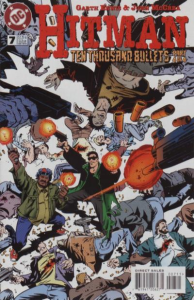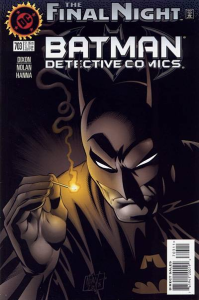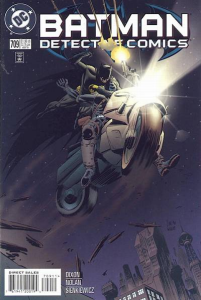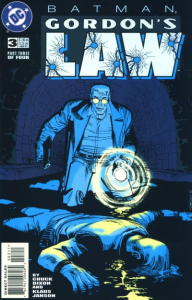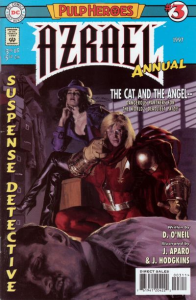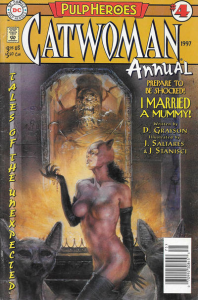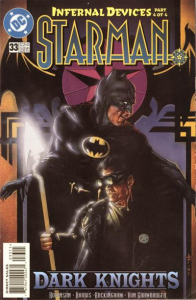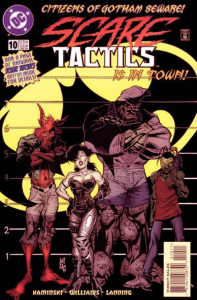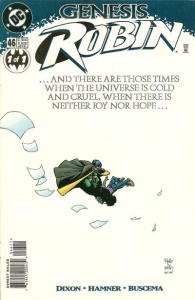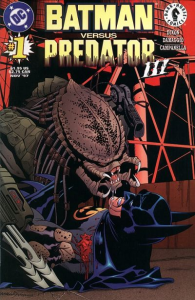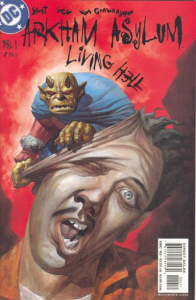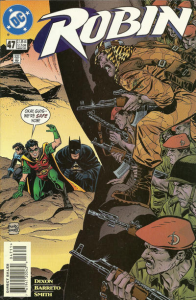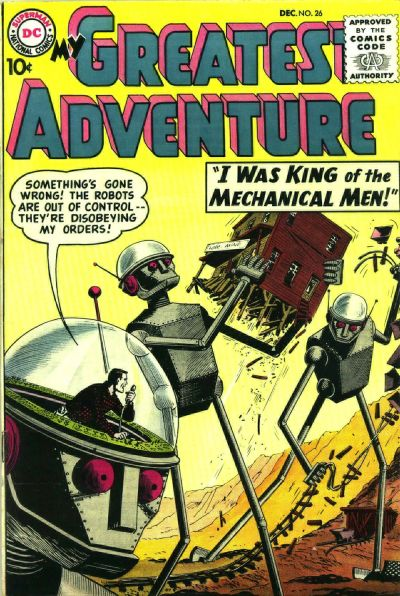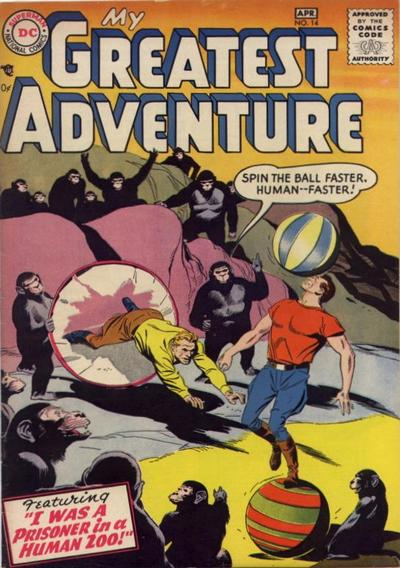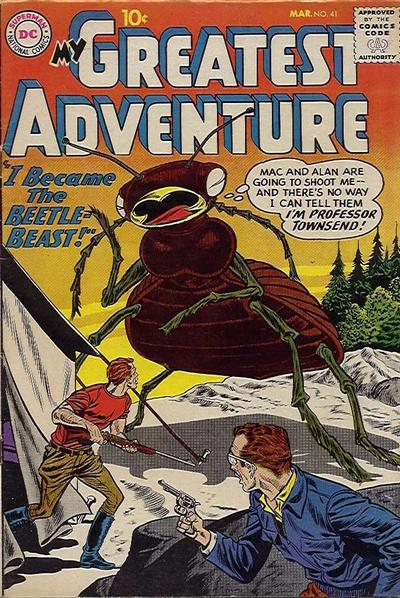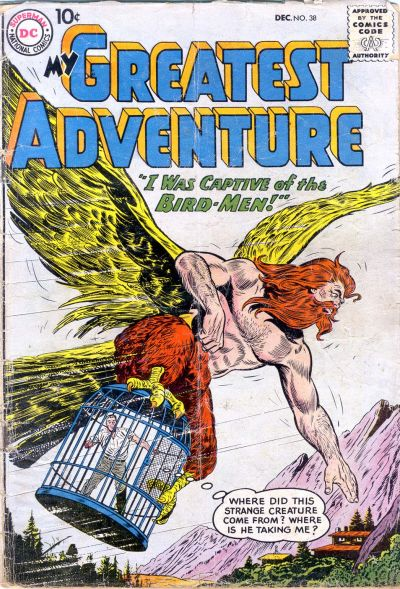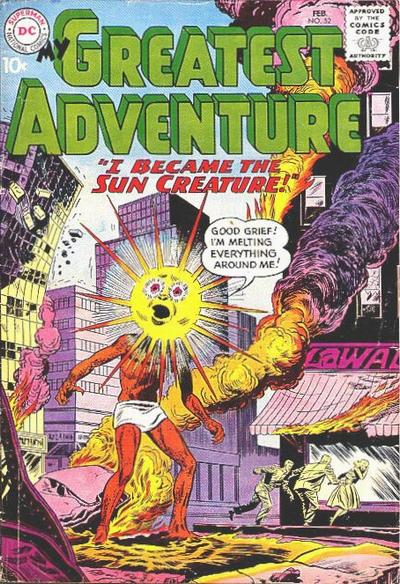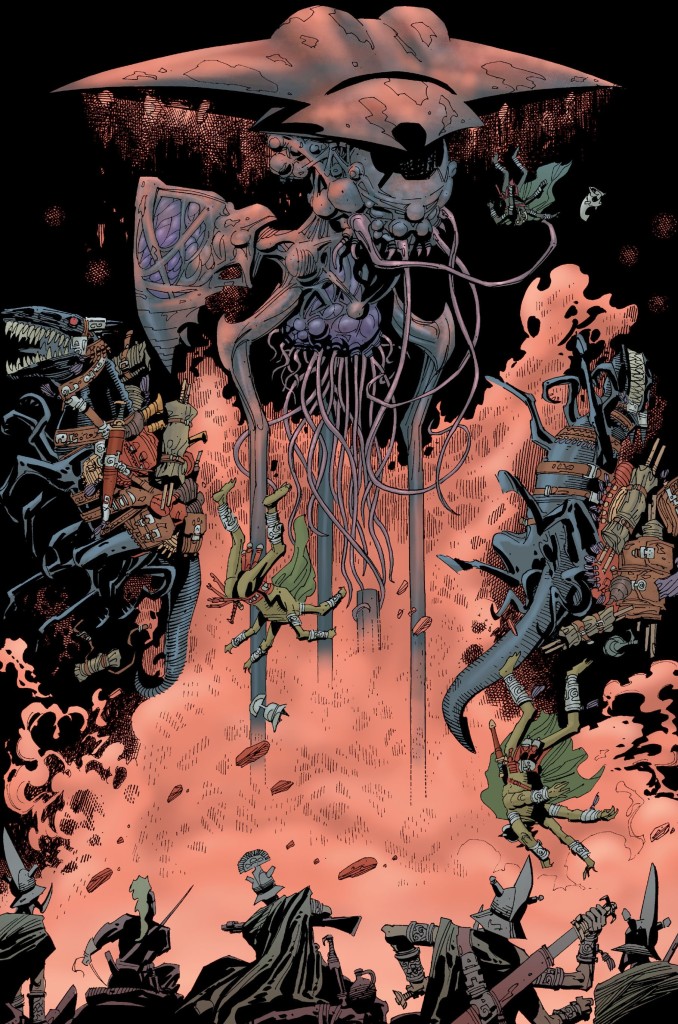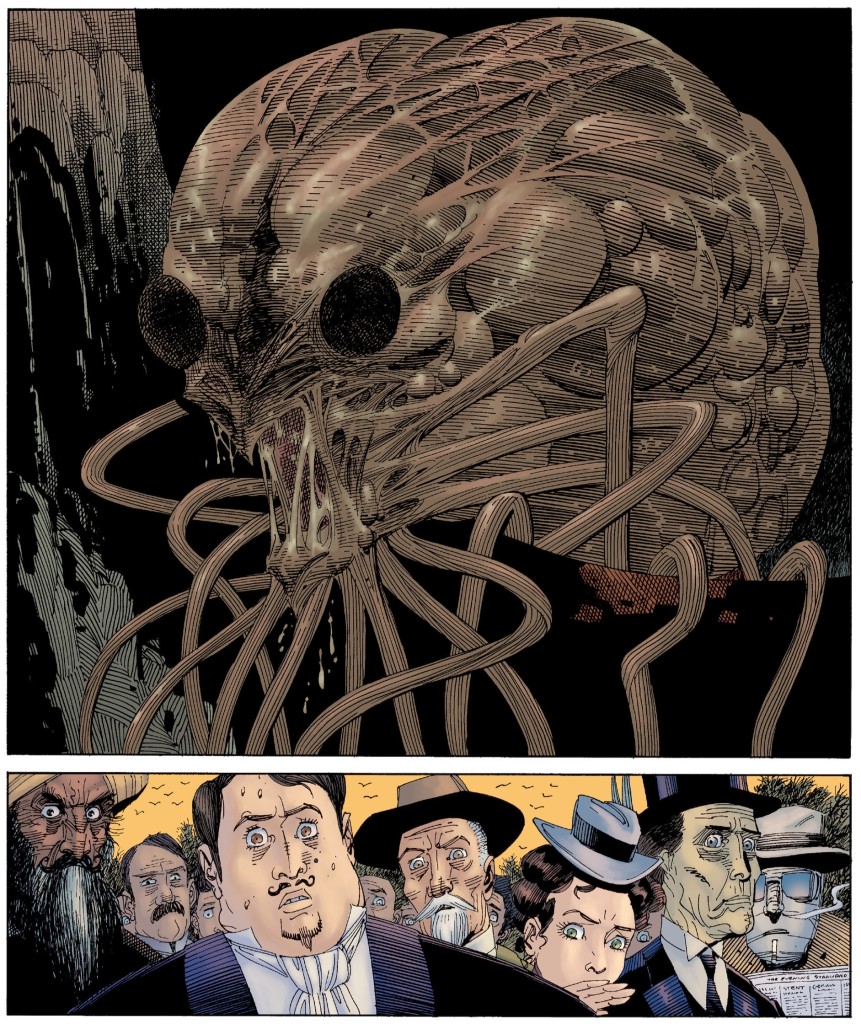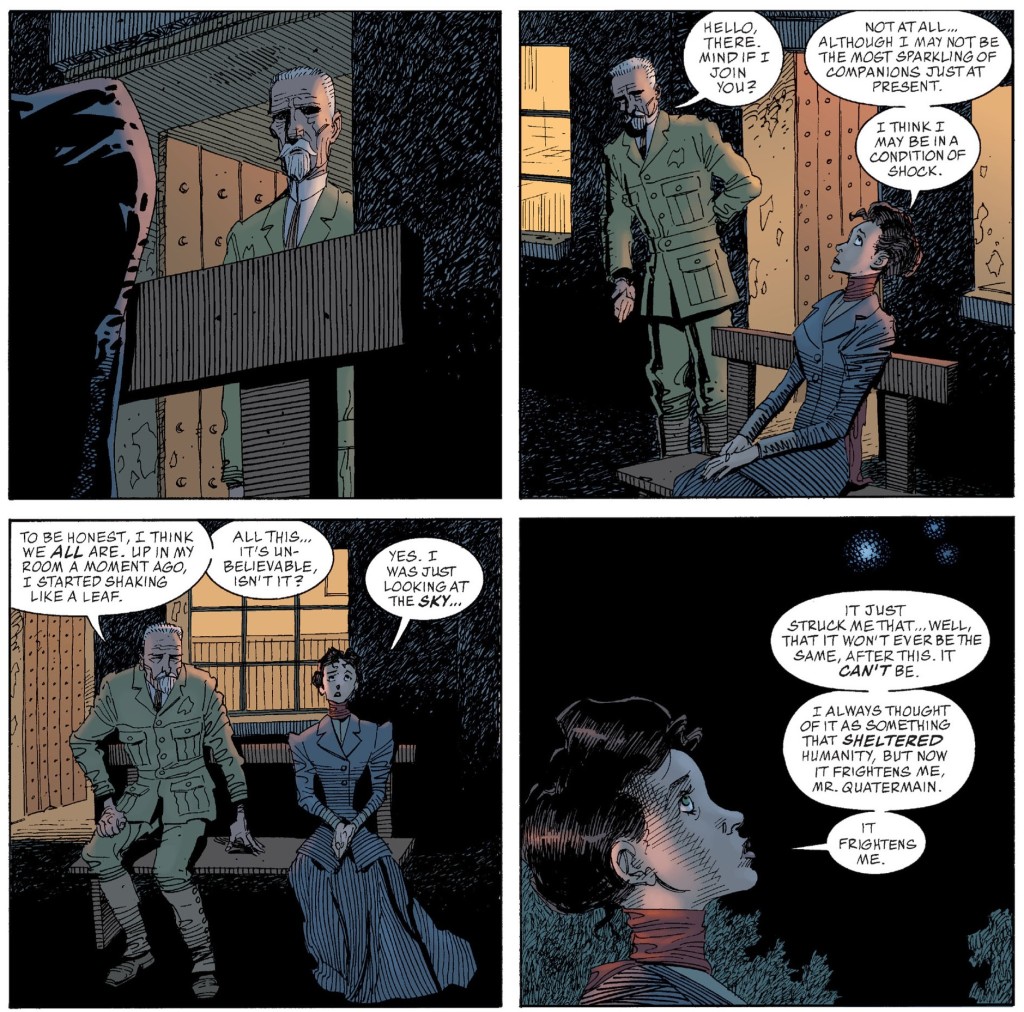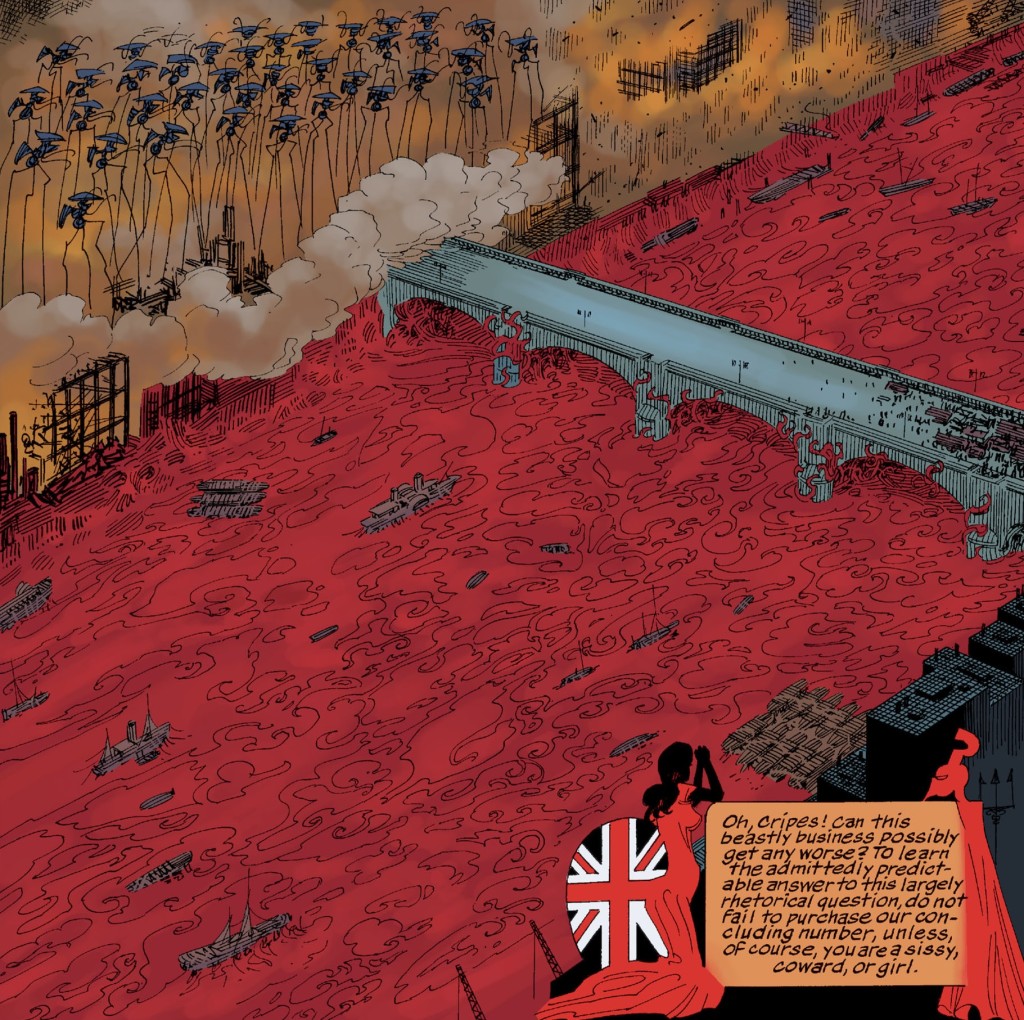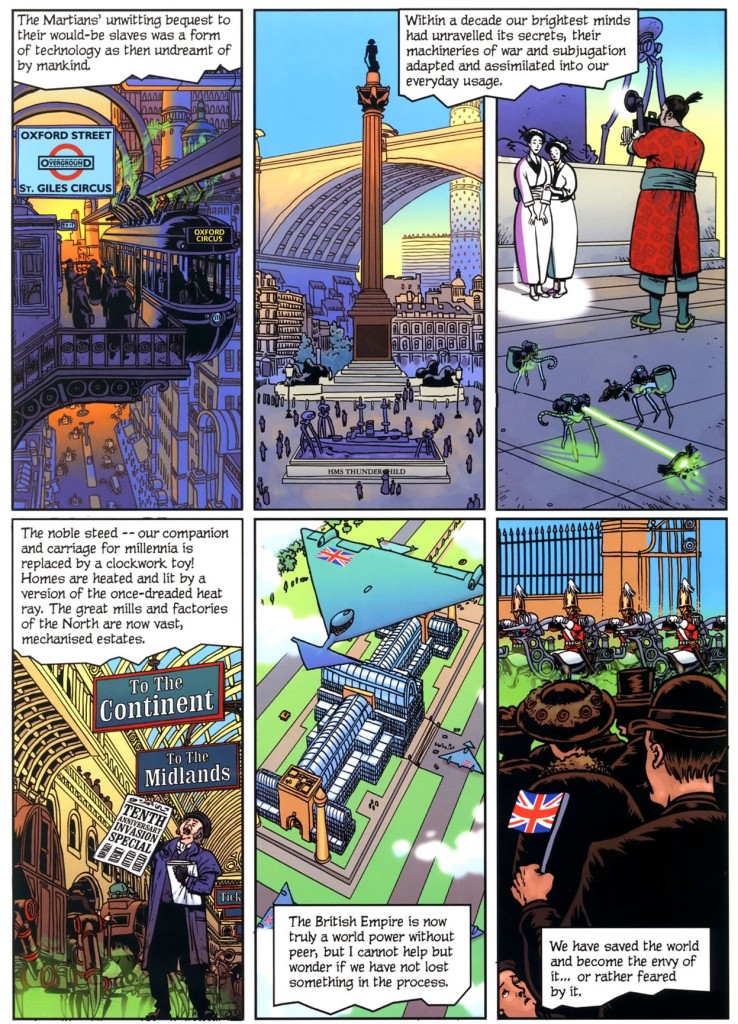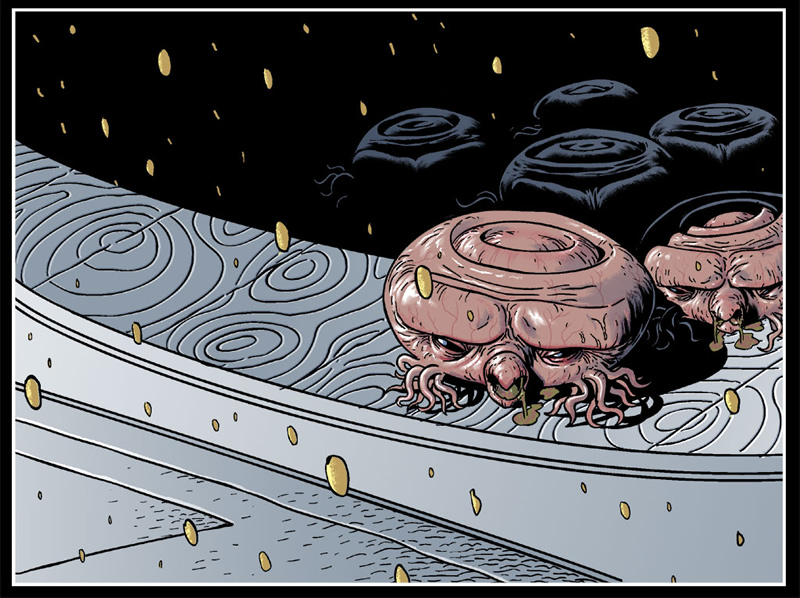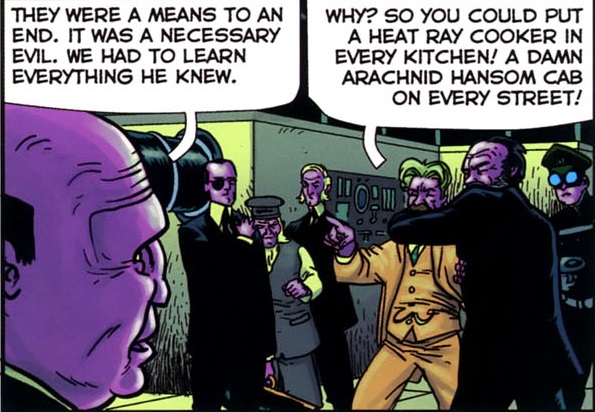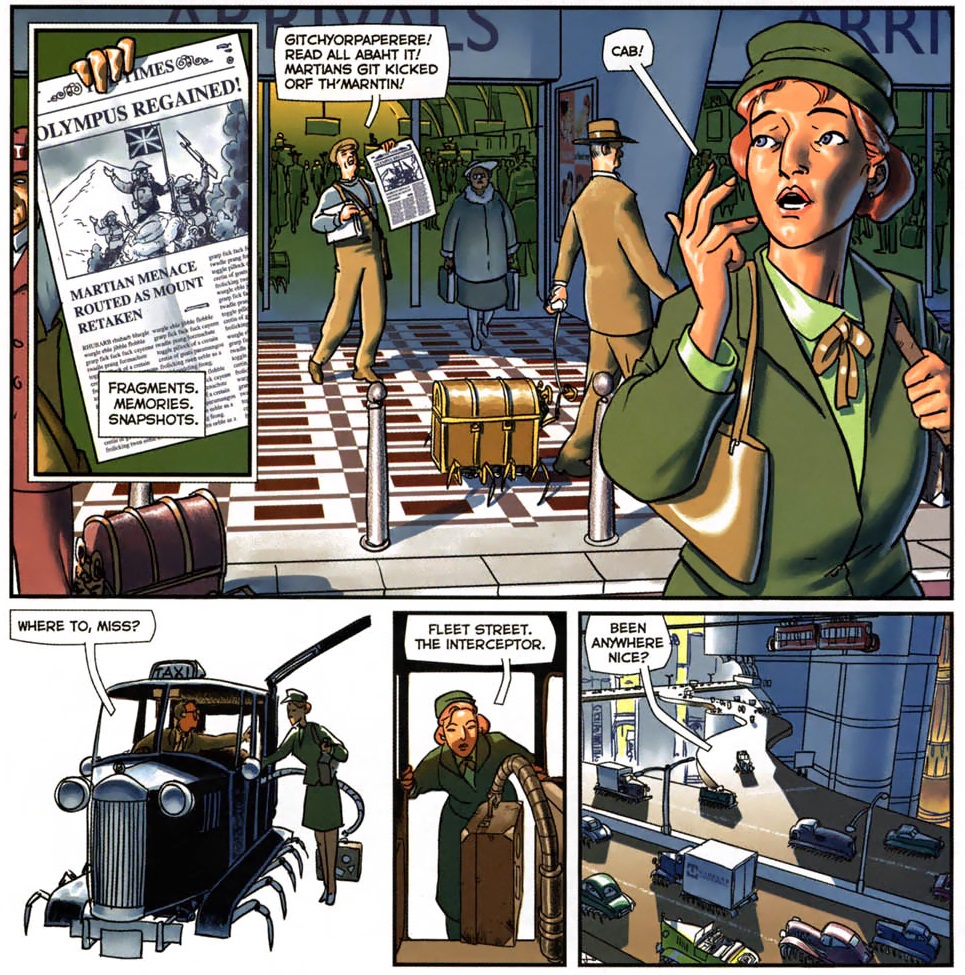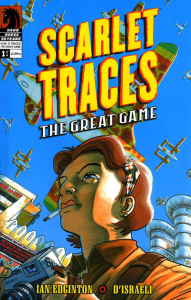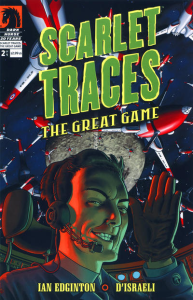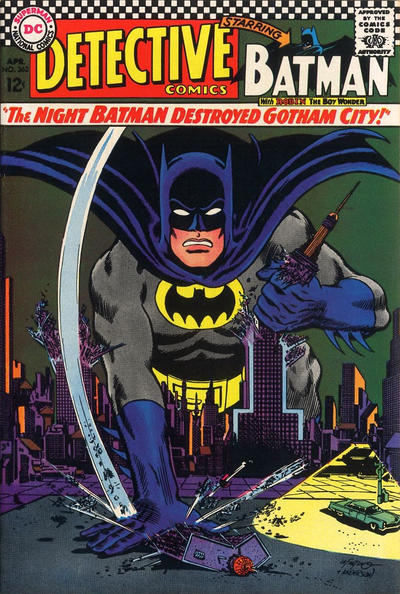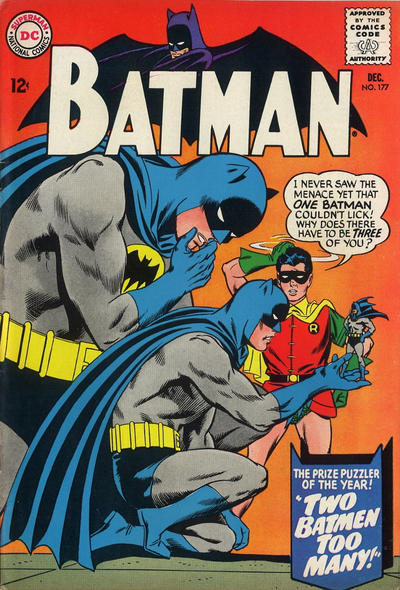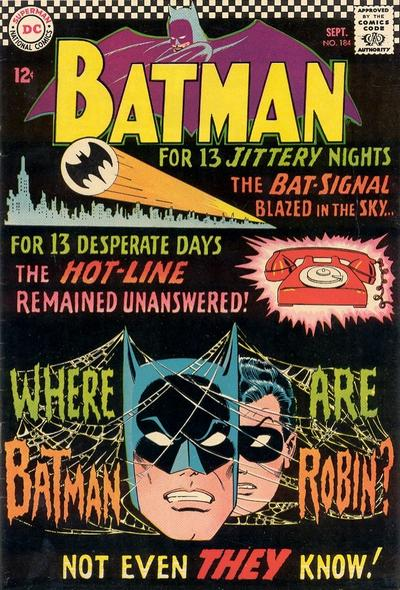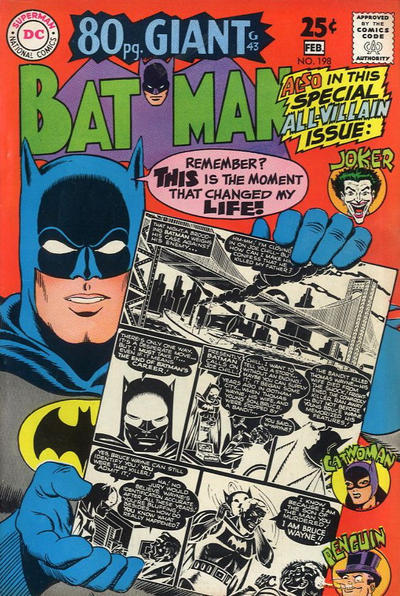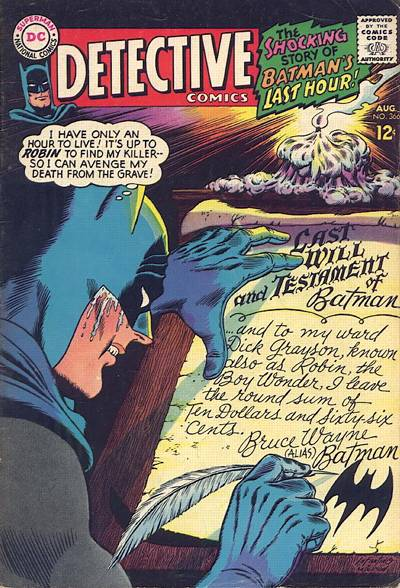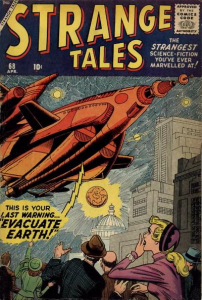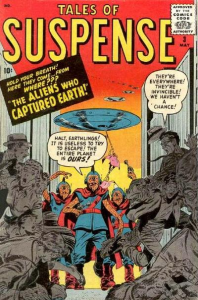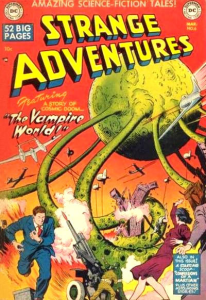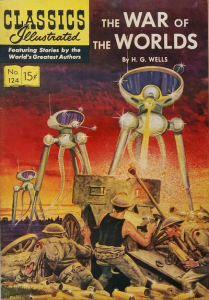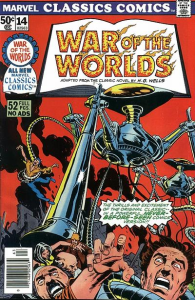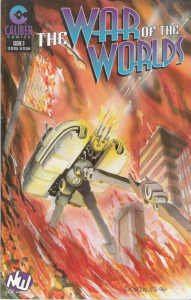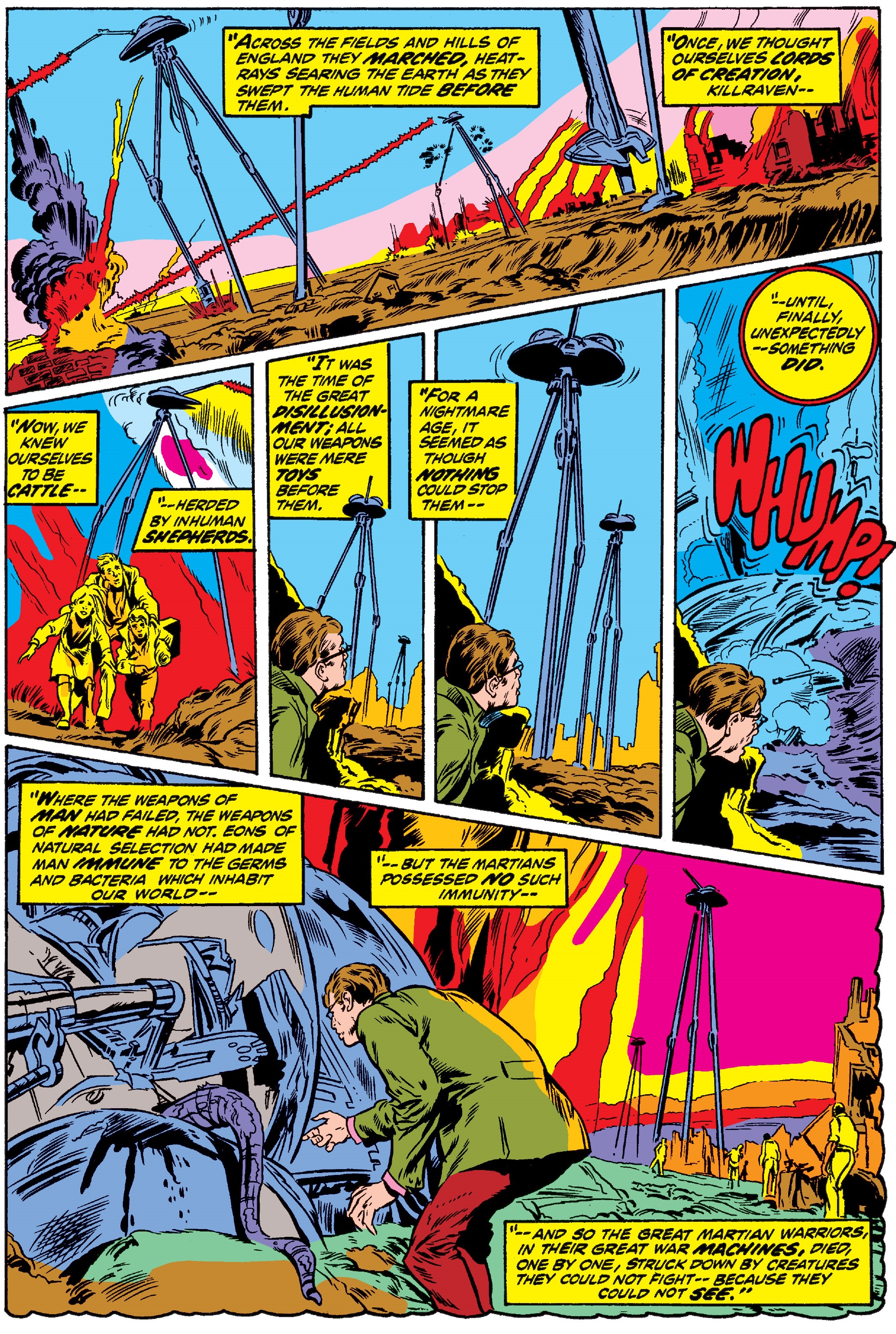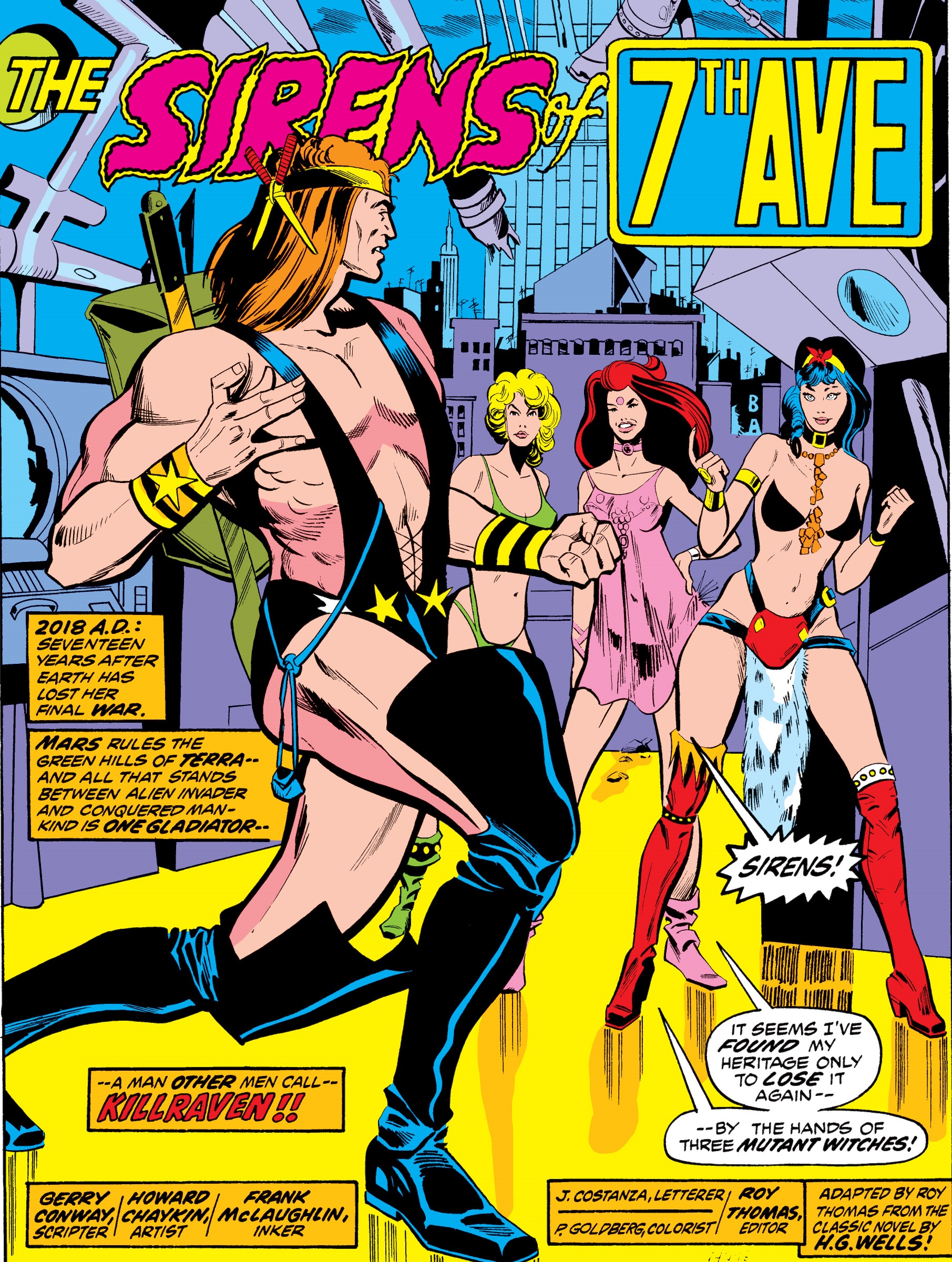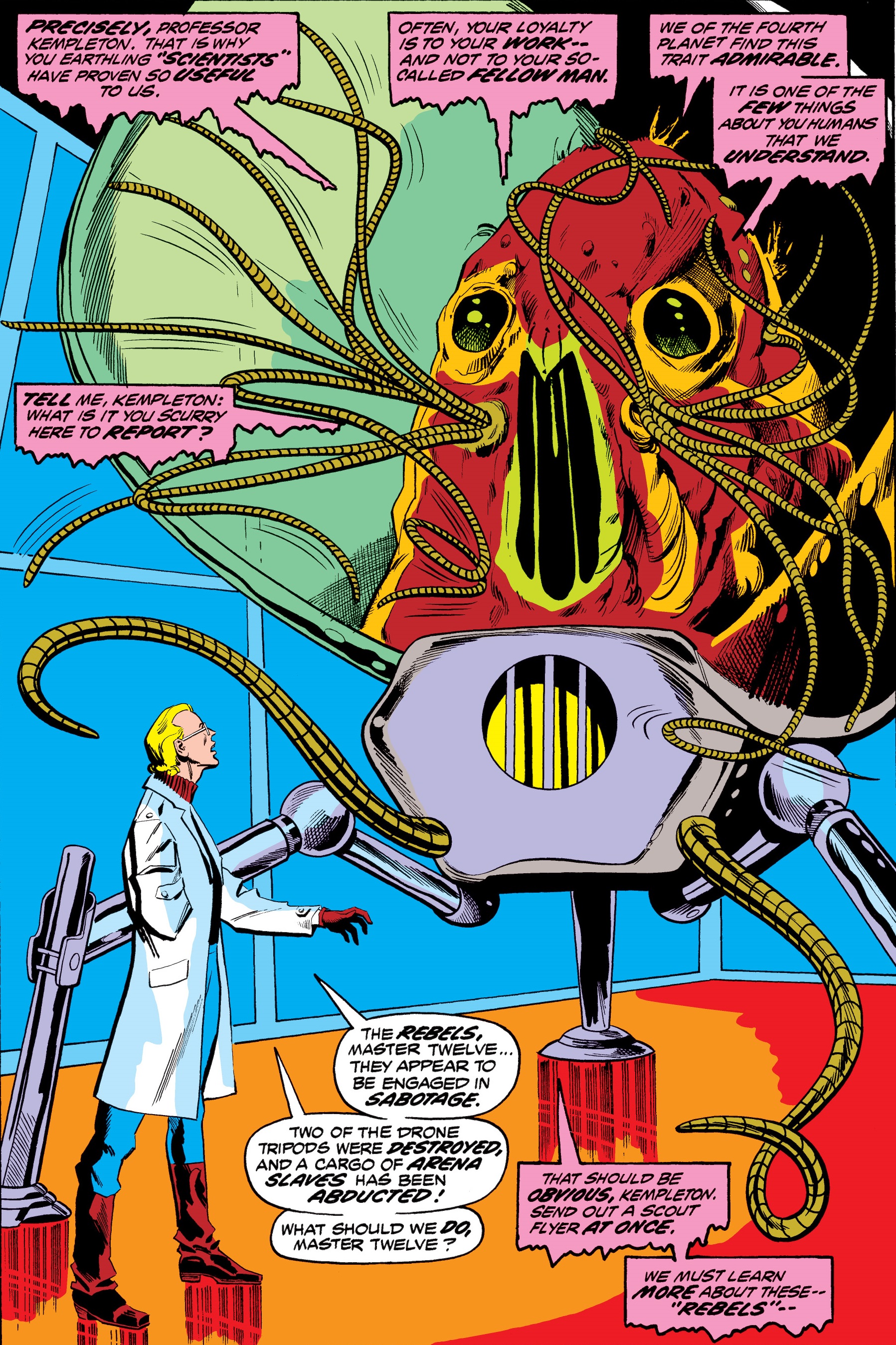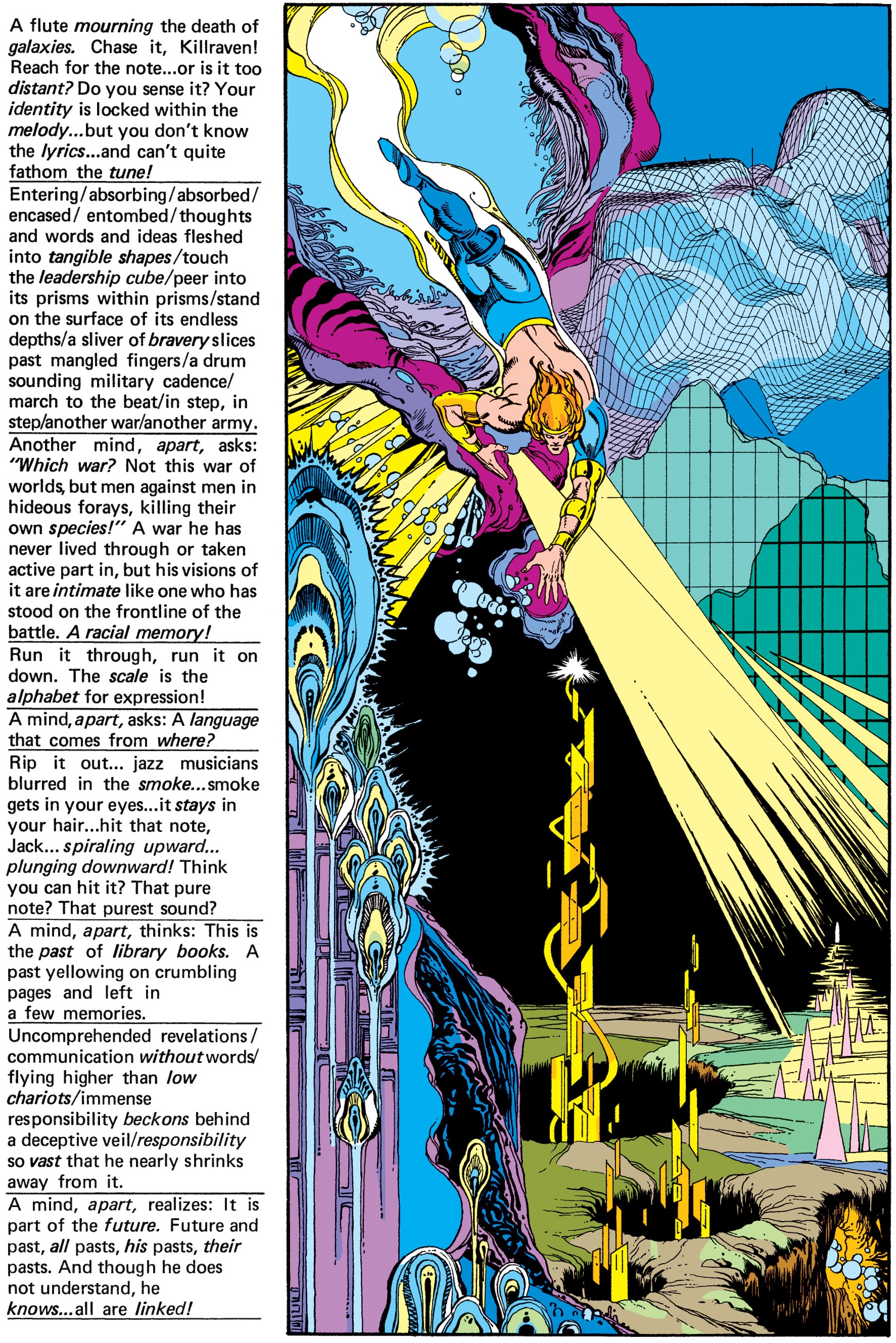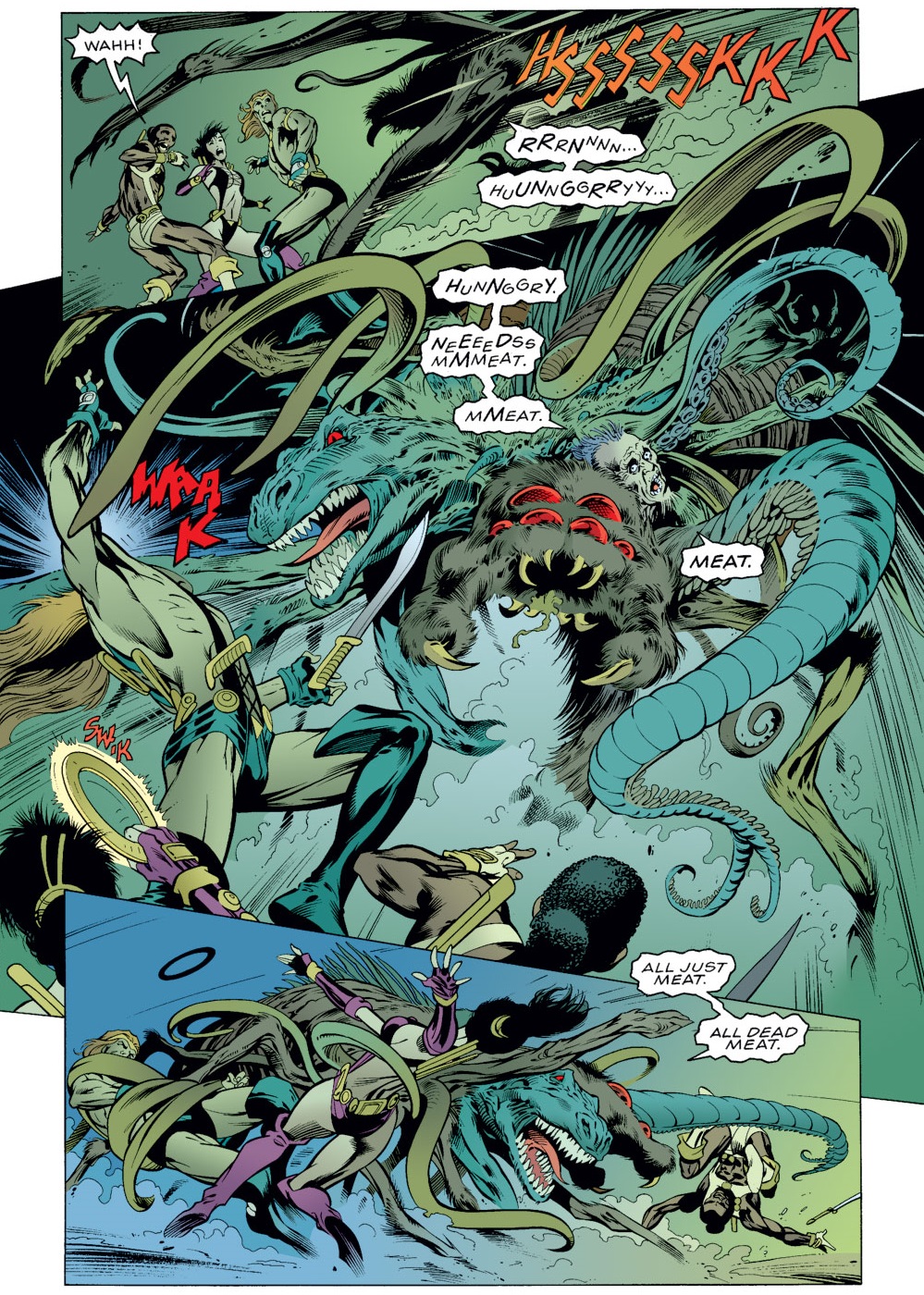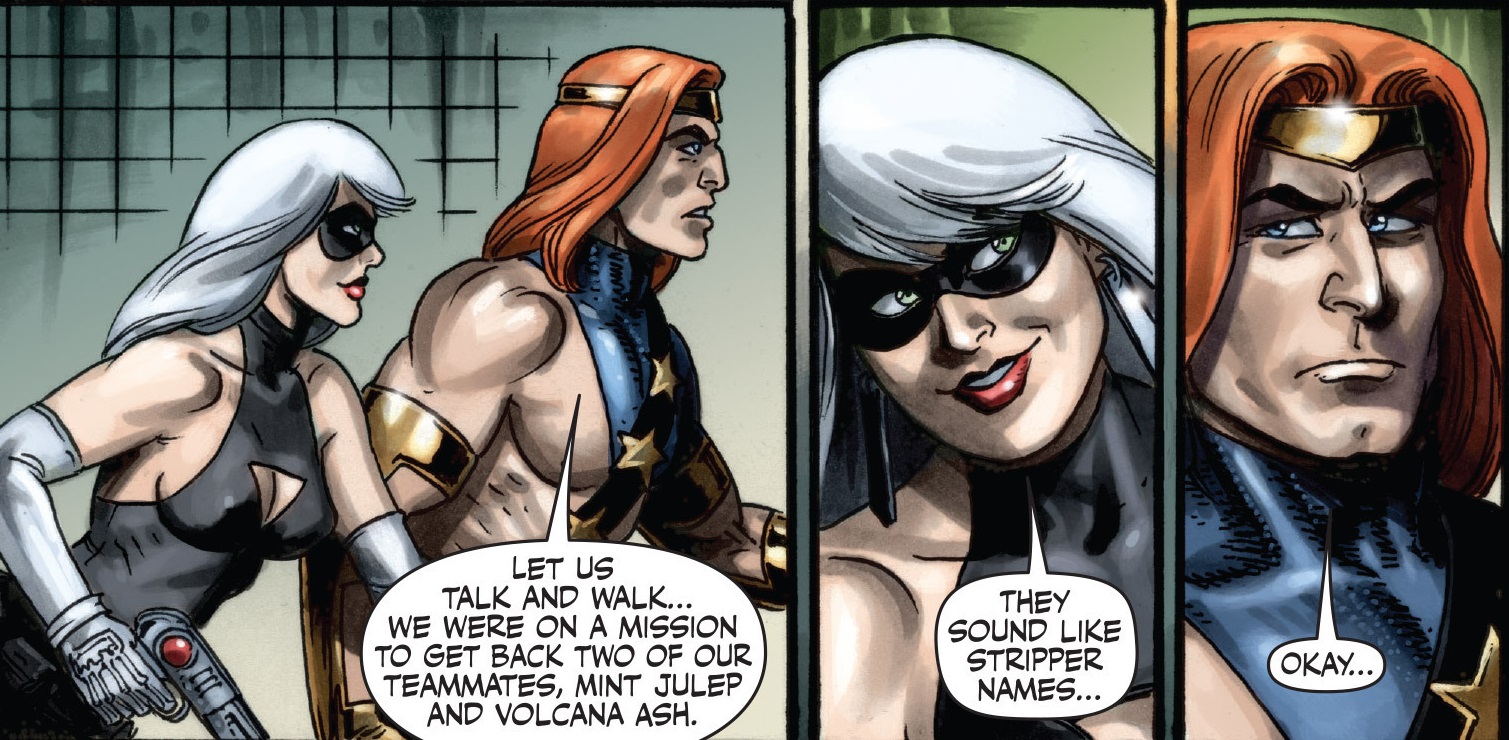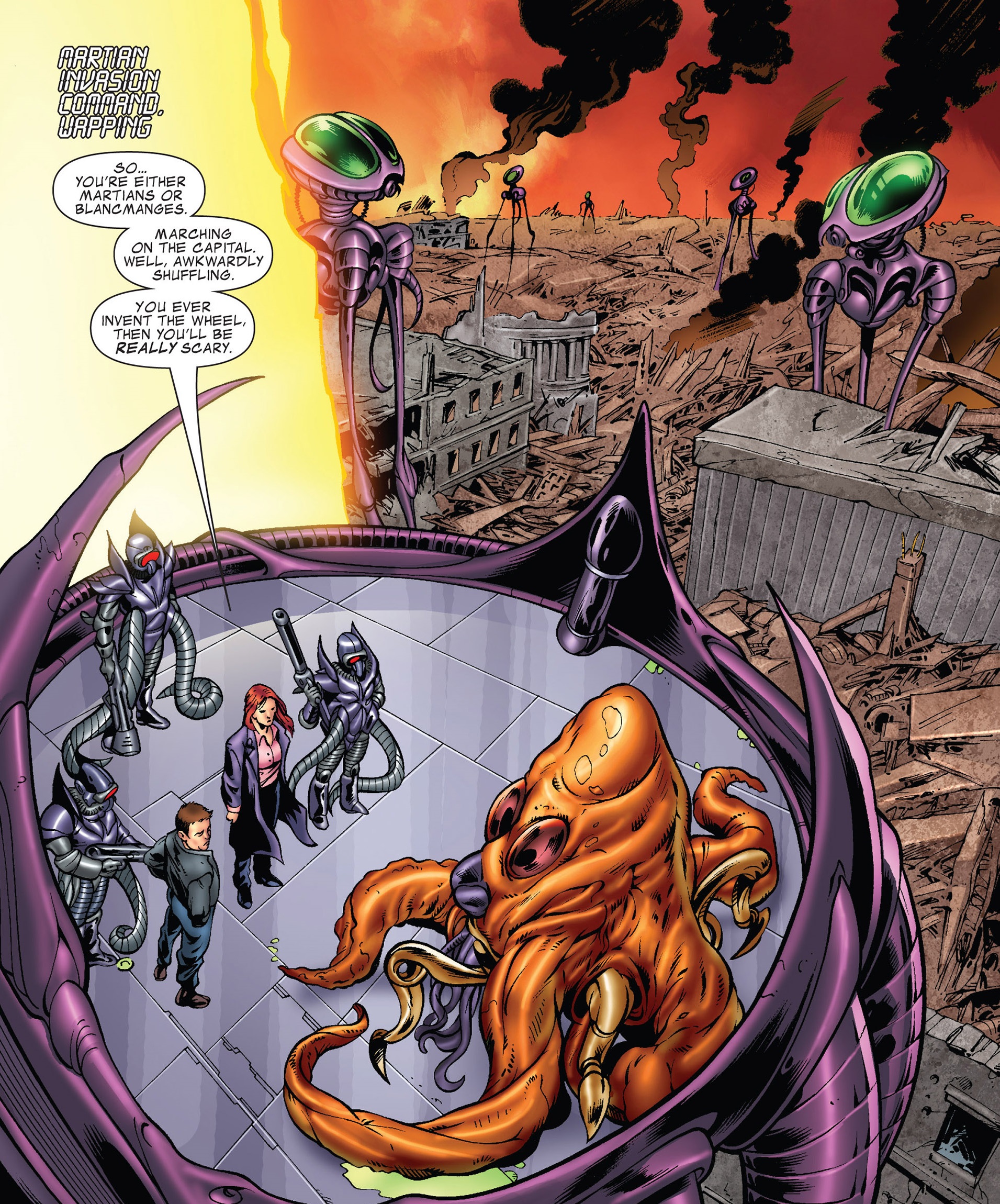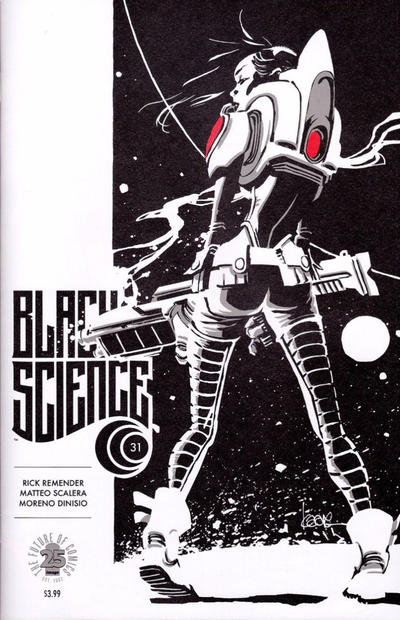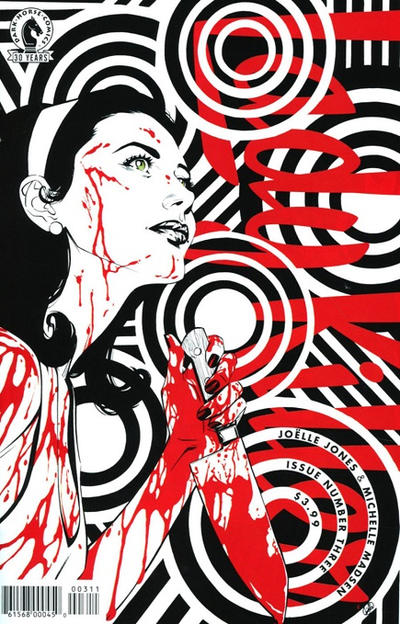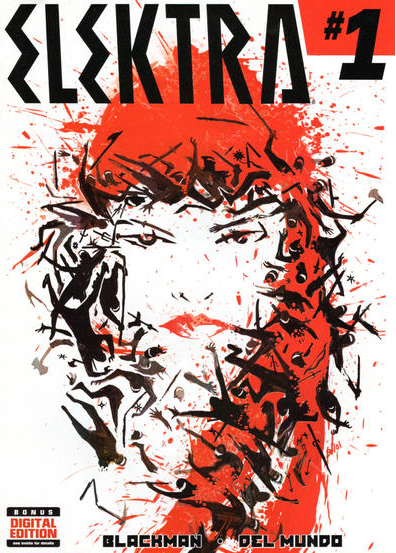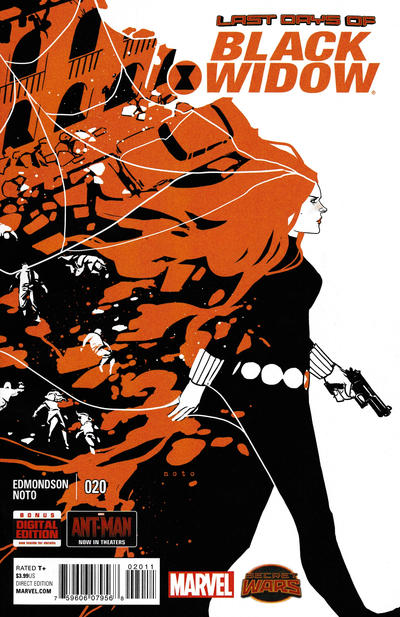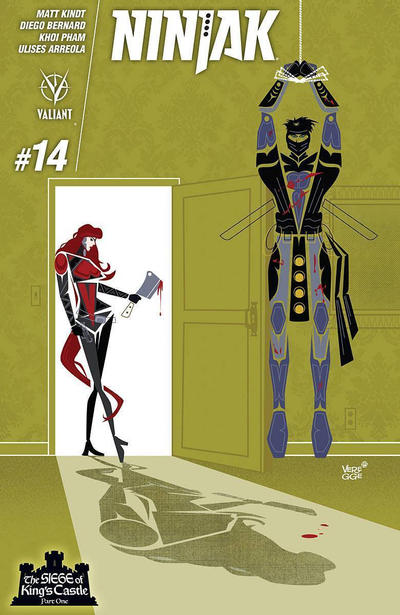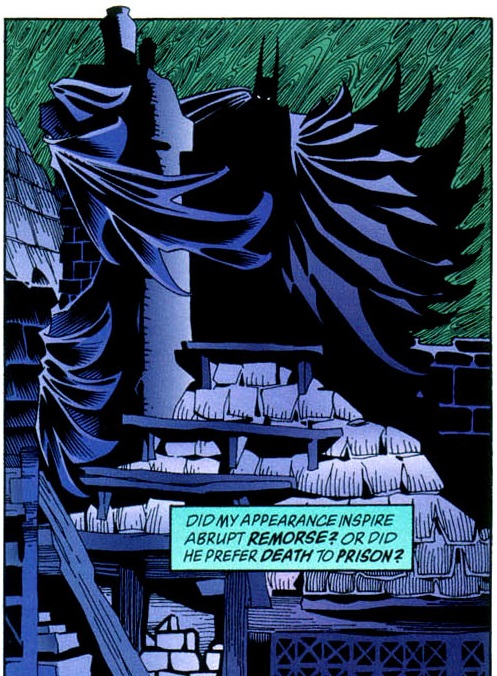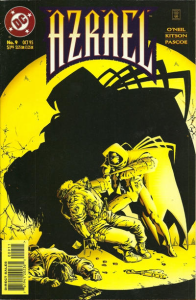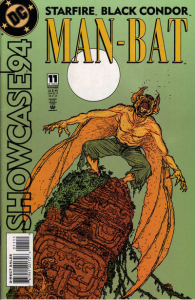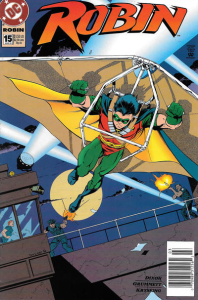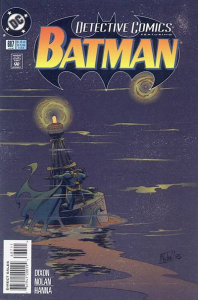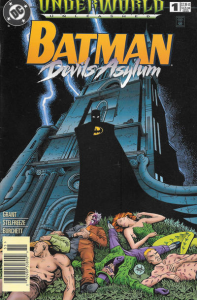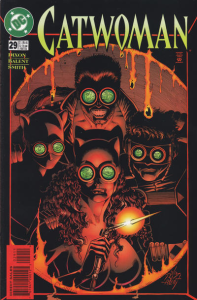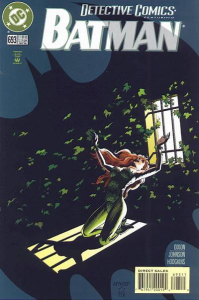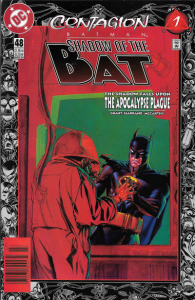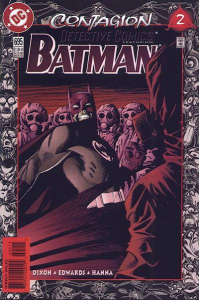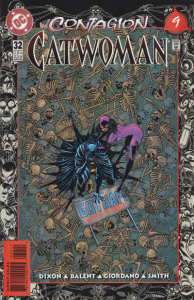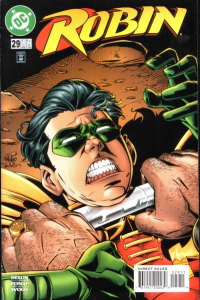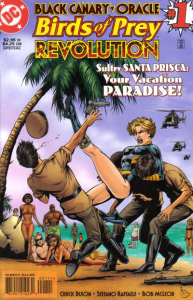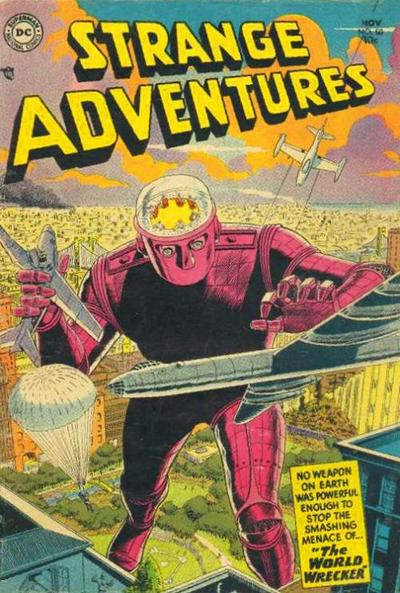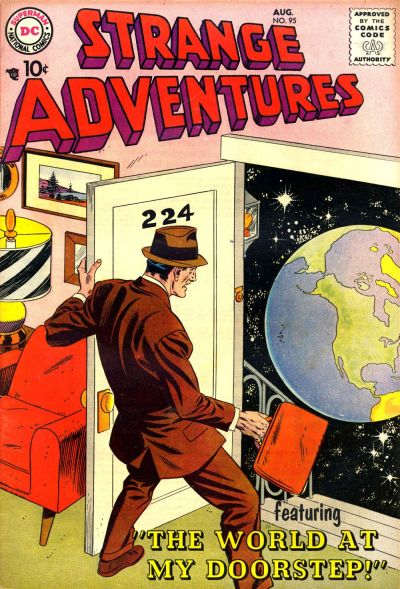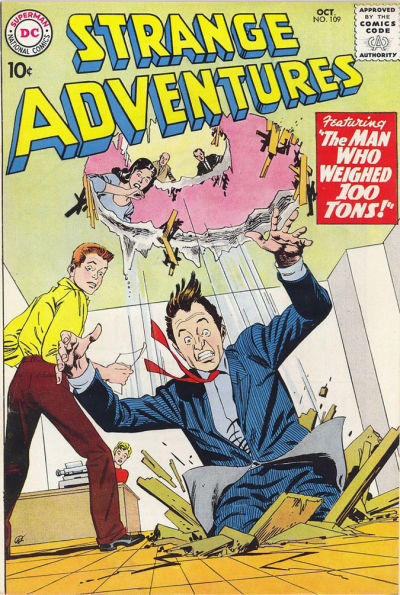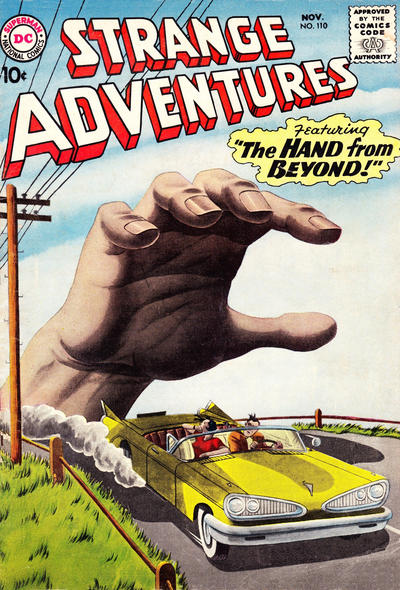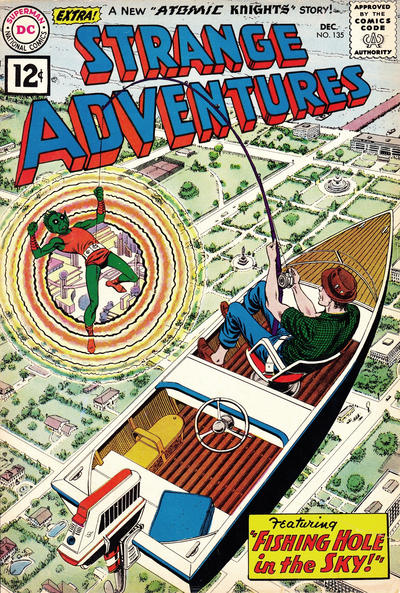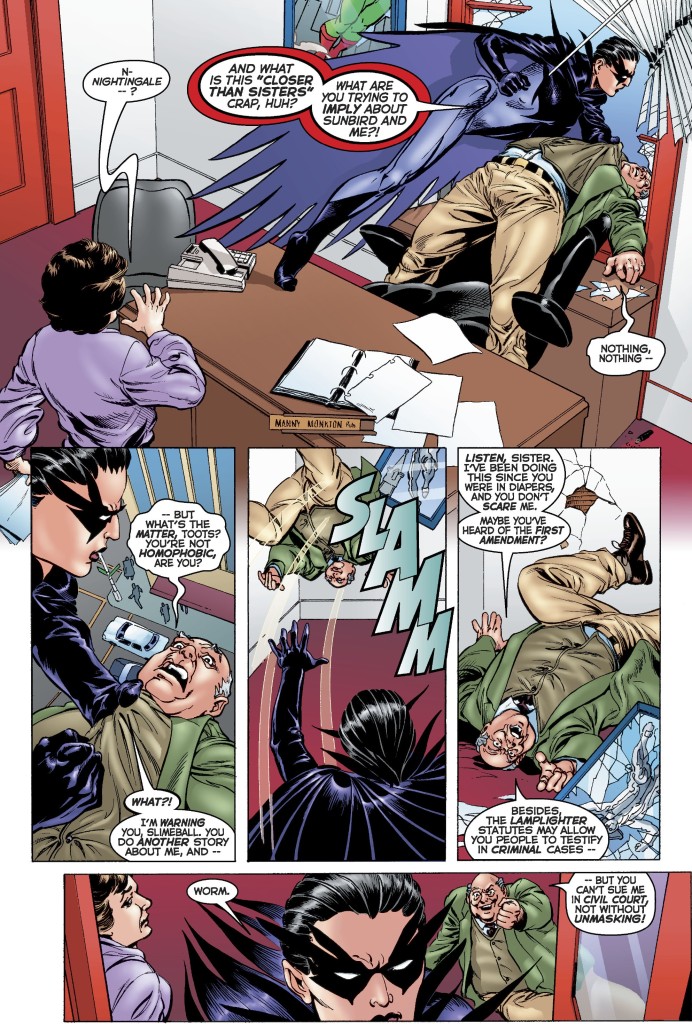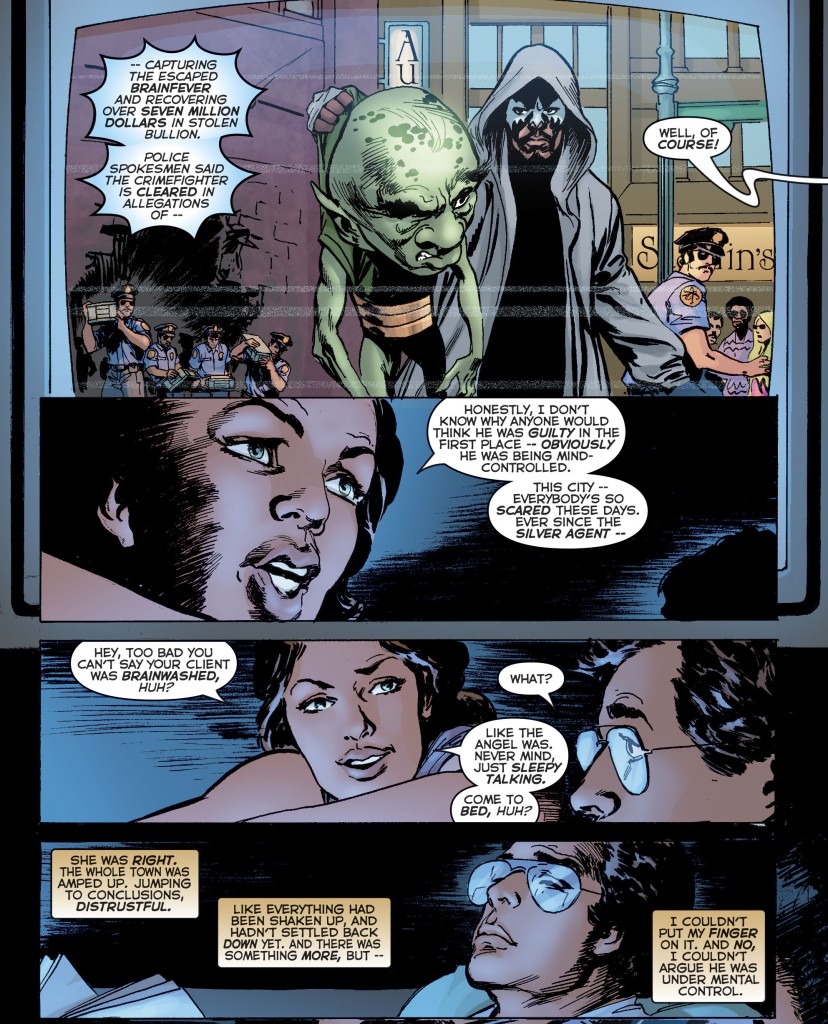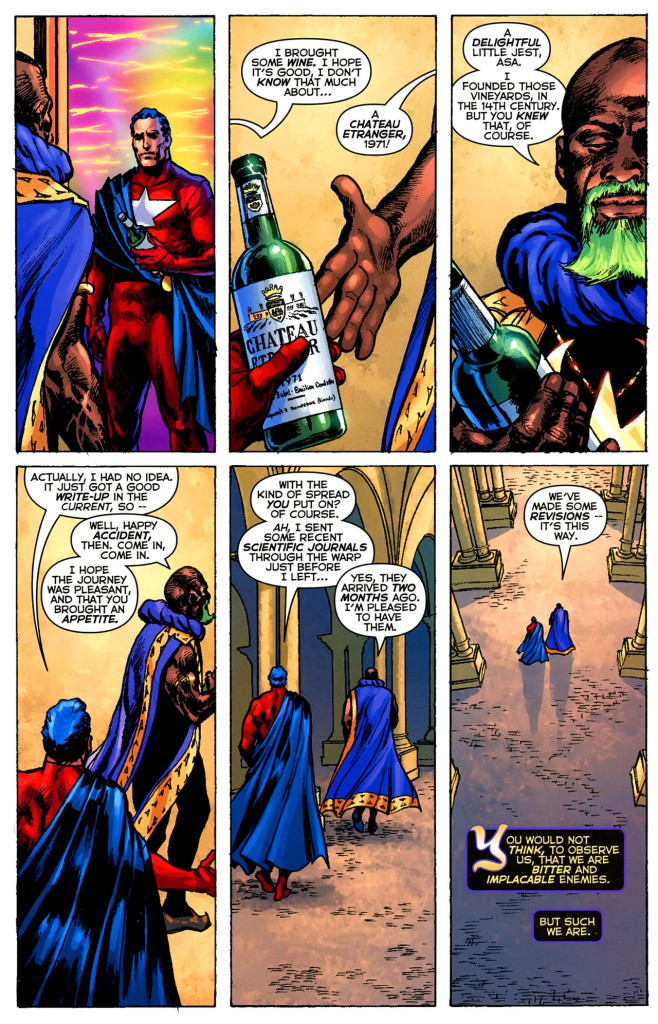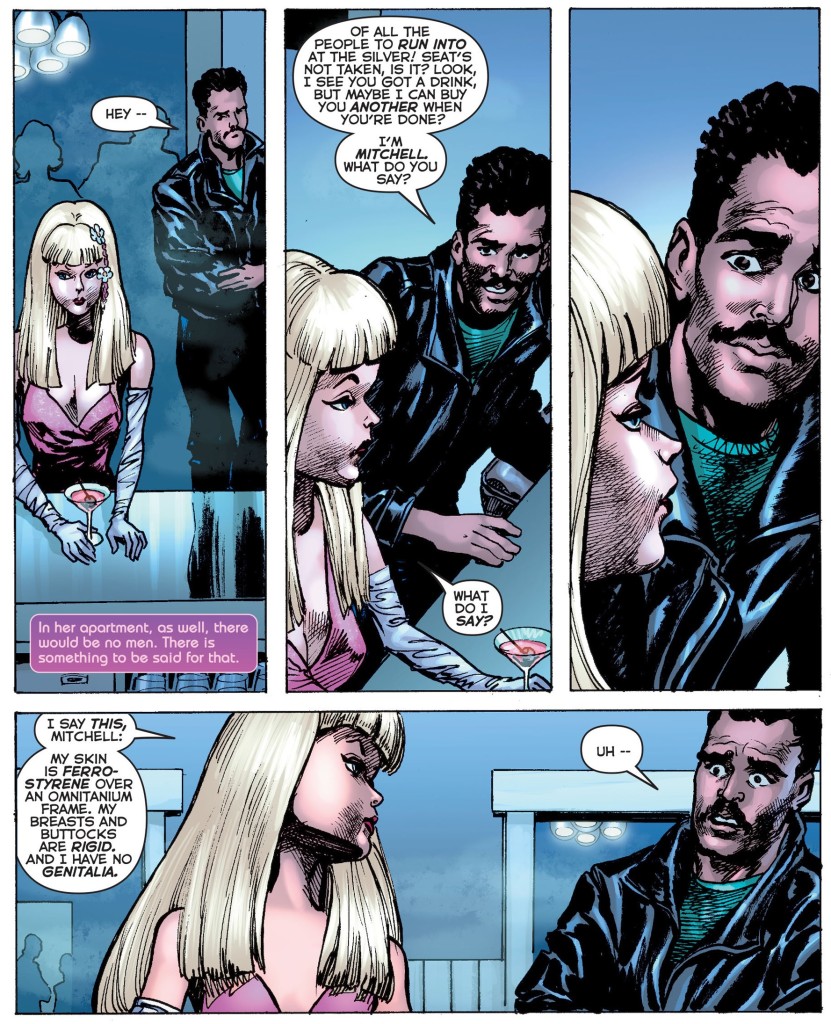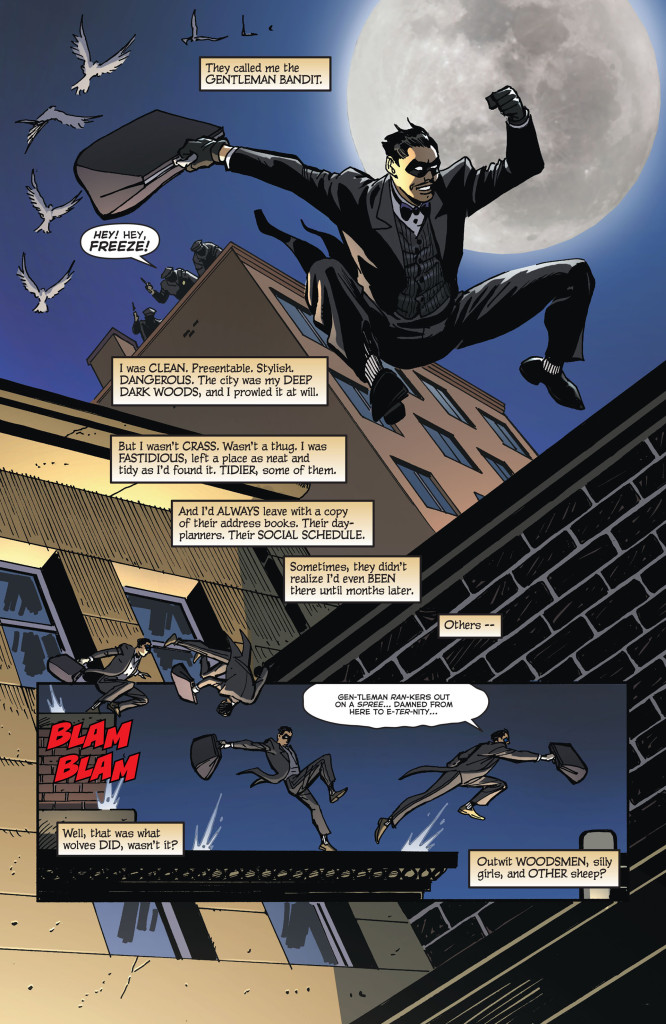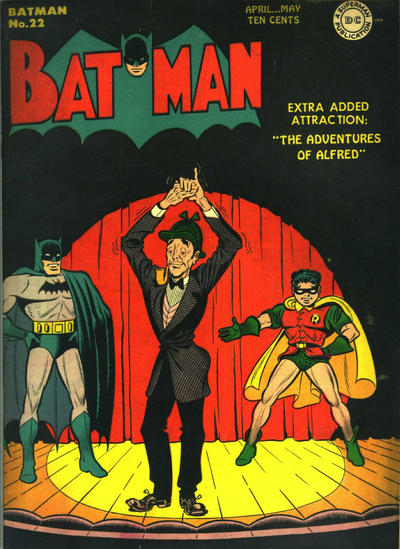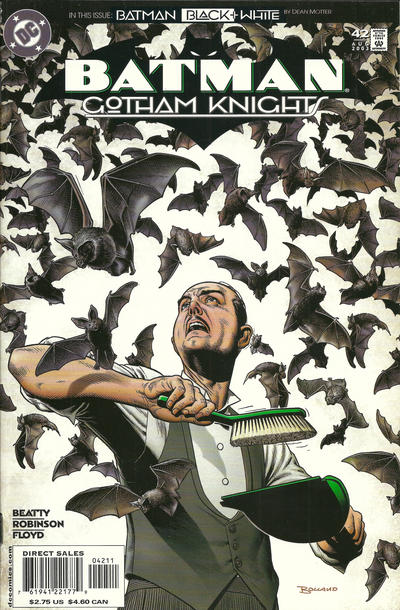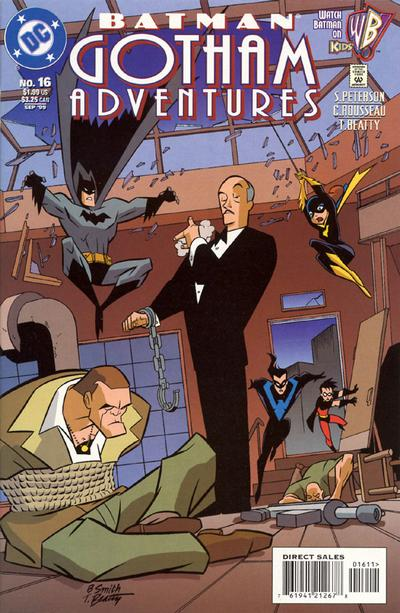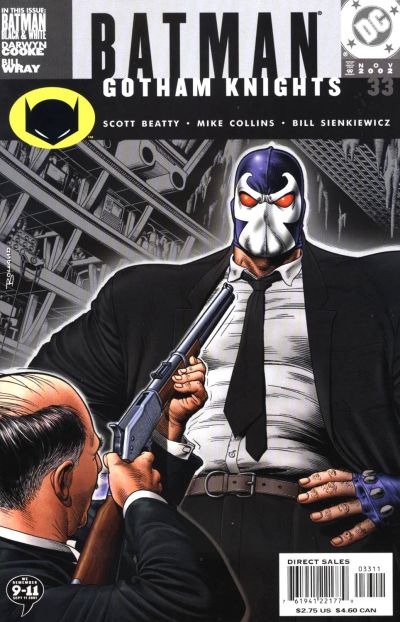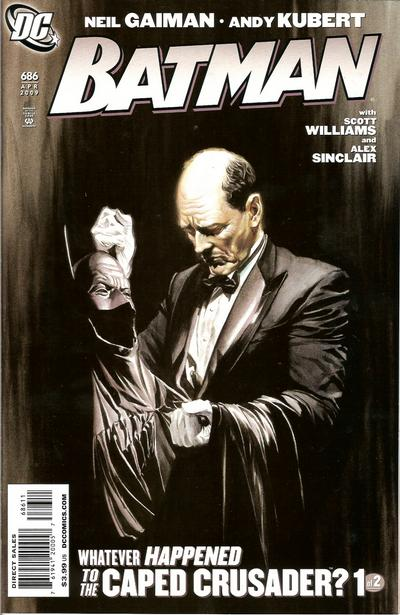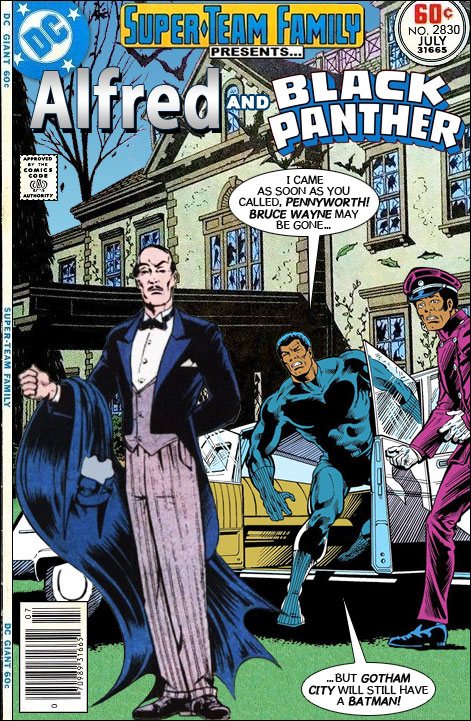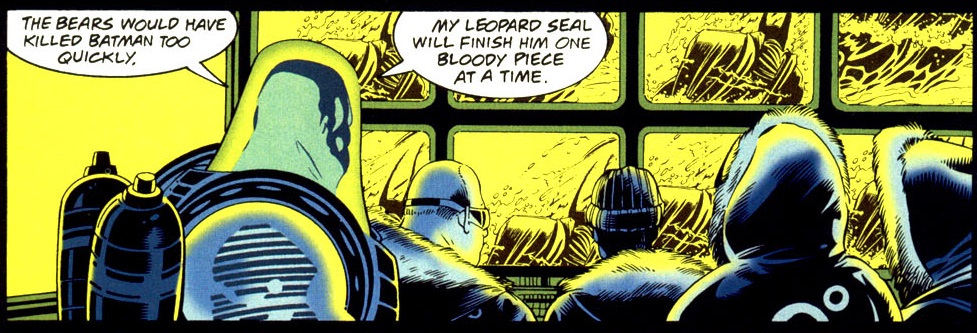 Batman: Mr. Freeze
Batman: Mr. Freeze
By the late ‘90s, not only had the Batman family of books become a well-oiled machine, but three new awesome spin-offs joined the line: Nightwing, about Dick Grayson reinventing himself as a solo vigilante in the neighboring city of Blüdhaven, with action-packed scripts by Chuck Dixon and ultra-stylized visuals by Scott McDaniel; Birds of Prey (initially a set of specials, later turned into a regular series, also penned by Dixon) about the partnership between the wheelchair-bound hacker Oracle and the globetrotting Black Canary; and the funniest of the lot, Hitman, about the telepathic contract killer Tommy Monaghan (this was technically a spin-off of Garth Ennis’ and John McCrea’s run on Demon, but set in the Cauldron, Gotham’s lower-class Irish district). Moreover, there was a proliferation of specials and mini-series, most of them quite good.
Meanwhile, Staz Johnson became the regular penciller on Robin, bringing in a relatively more realistic – yet dynamic – style to the series. Azrael’s look also improved drastically once artist Roger Robinson came on board. In turn, Chuck Dixon’s replacement by Doug Moench as the main writer of Catwoman resulted in much less inspired scripts (can’t win them all, I suppose). Moreover, Devin K. Grayson became one of the franchise’s go-to writers, penning scattered tales (usually featuring Nightwing or Catwoman). In terms of the larger narrative, Batman returned to the Justice League of America (followed by Oracle and the Huntress) – and while I’ve mostly stayed clear of the superhero team books so far, I’ve decided to include some JLA-related material in this final stretch because much of it was written by Grant Morrison, so you can see him establish the approach to the Caped Crusader he would later develop in his Batman run in the 2000s.
That said, after 1996’s Legacy crossover the regular series once again went their different ways for a while, now with less subplots tying them together. Even the tie-ins to the larger DC events worked relatively well on their own, with no need to read other comics to get what was going on. This means that, for the most part, you can follow each series independently up until 1998’s Cataclysm crossover. With that in mind, instead of jumping around between individual issues, this time I’ll just list blocks of issues for each series (in alphabetical order) to be read between larger events.
Batman #535 (collected in Batman by Doug Moench & Kelley Jones, v1)
Birds of Prey: Manhunt #1-4 (collected in Birds of Prey, v1)
Detention Comics: ‘Momma’s Boy’ [This special anthology includes a Robin story.]
Hitman #1-7 (collected in Hitman, v1 & 2)
Justice League: A Midsummer’s Nightmare #1-3 (collected as Justice League: A Midsummer’s Nightmare ) [The mini-series by Mark Waid, Fabien Nicieza, Jeff Johnson, and Darick Robertson that brought together the main heroes in the DC Universe (including Batman), ushering in the revamped JLA.]
Robin (v4) #34
THE FINAL NIGHT [All you need to know about this DC crossover is that an alien entity has consumed the sun.]
Batman #536: ‘Darkest Night of the Man-Bat: Predation’ (collected in Batman by Doug Moench & Kelley Jones, v2) [Moench’s approach to Kirk and Francine Langstrom in this arc feels much closer to the pre-Crisis version of the characters than to Dixon’s recent reboot.]
Detective Comics #703: ‘Howling in the Dark’
Hitman #8: ‘The Night the Lights Went Out’ (collected in Hitman, v2: Ten Thousand Bullets)
Robin (v4) #35: ‘Iced!’
Batman #537-358: ‘Darkest Night of the Man-Bat: Pursuit/Predemtion’ (collected in Batman by Doug Moench & Kelley Jones, v2) [Wraps up the storyline from Batman #536, but it takes place after The Final Night.]
POST-FINAL NIGHT
Azrael #21-26
Azrael + The Question [This team-up special, set after Azrael #26, features not only the Question (next seen in The Question Returns one-shot), but also Junior Musto, from Denny O’Neil’s cult run on The Question.]
Aztek, the Ultimate Man #1-10 (collected as JLA Presents: Aztek, The Ultimate Man) [Since I’ve decided to include JLA material, I might as well add this nifty spin-off (co-written by Morrison) as well. Plus, issues #6-7 do guest-star Batman and the Joker. The final issue (#10) takes place at the same time as JLA #5, so it works better if read immediately afterwards.]
Batman #539-541 (collected in Batman by Doug Moench & Kelley Jones, v2)
The Batman Chronicles #6-7
Blackgate: ‘Hatred’s Home’
Detective Comics #704-711 [The issue ‘Knight Out’ (#711), about Bruce Wayne’s love life, works better if read before Bruce meets Vesper Fairchild, in Batman #540.]
Flash + Nightwing [A team-up special by Brian Augustyn, Mark Waid, and Eduardo Barreto]
Gordon’s Law #1-4 (collected in Gordon of Gotham) [An awesome crime yarn starring Commissioner James Gordon, by Dixon and Klaus Janson.]
Hitman #9-12 (collected in Hitman, v3: Local Heroes) [Set before JLA #5, since it still references Superman’s long-haired look.]
JLA #1-5 (collected in JLA Deluxe Edition, v1 and JLA by Grant Morrison Omnibus; the first four issues also collected as JLA, v1: New World Order) [‘Woman of Tomorrow’ (#5) features Superman’s radical new look and cameos by Aztek and Tommy Monaghan. It runs parallel to Aztek #10 and to the neat JLA: Tomorrow Woman one-shot (by Tom Peyer and Yannick Paquette), which should be read afterwards.]
Legends of the Dark Knight #94: ‘Stories’ [A wonderful issue (by Michael T. Gilbert) in which characters stuck in an elevator compare their memories of meeting Batman, done in the style of various different eras.]
Batman: Poison Ivy (collected in Arkham: Poison Ivy) [One-shot by John Francis Moore and Brian Apthorp]
Robin + Impulse [A team-up special by Brian Augustyn, Mark Waid, and John Royle]
Shadow of the Bat #56-58 [‘Leaves of Grass,’ featuring Floronic Man with a new body after having been recently decapitated in Swamp Thing #170.]
PULP HEROES [Not exactly a crossover: DC’s 1997 annual issues were all pastiches of pulp magazines – thus, while they don’t have to be read together, it’s fun do so!]
Azrael Annual #3: ‘The Vampire Bat’ [Done in the style of a noirish detective yarn (specifically, The Maltese Falcon)]
Batman Annual #21: ‘The Scream of the Green Dragon’ (collected in Tales of the Batman: J.H. Williams III) [Done in the style of The Shadow]
Catwoman Annual #4: ‘I Married a Mummy’ [Done in the style of a horror/fantasy adventure]
Detective Comics Annual #10: ‘Warrior Breed’ [Done in the style of two-fisted war action]
Hitman Annual #1: ‘Coffin Full of Dollars’ (collected in Hitman, v2: Ten Thousand Bullets) [Done in the style of a western]
JLA Annual #1: ‘Hardboiled Hangover/Lockdown’ [Done in the style of hardboiled mystery and two-fisted action]
Nightwing Annual #1: ‘Forever Hold Your Peace’ (collected in Nightwing, v2: Rough Justice (2015 edition)) [Done in the style of a romance potboiler]
Robin Annual #6: ‘The Law West of Gotham’ [Another western]
Shadow of the Bat Annual #5: “I was the love-slave of a plant-based killer!” [Another noirish detective yarn]
POST-PULP HEROES
Anarky #1-4 (collected in Batman: Anarky) [This mini-series must be set after Hitman #20.]
Azrael #27-33
Batman: Bane (collected in Legacy, v2 (2018 edition)) [Bear in mind that this one-shot (by Chuck Dixon and Rick Burchett) takes place after Nightwing has started operating in Blüdhaven, at the beginning of the Nightwing ongoing series.]
Batman #542-546 (collected in Batman by Doug Moench & Kelley Jones, v2)
Batman + Arsenal [Like Bane, this team-up special (by Devin K. Grayson and Rodolfo Damaggio) takes place after Nightwing has moved to Blüdhaven.]
The Batman Chronicles #8-10
Batman / Wildcat #1-3 (collected in Batman/Wildcat)
Catwoman (v2) #41-53 [I skipped #38-40, because it consists of a goofy ‘Year Two’ story]
Detective Comics #712-713
Hitman #13-20 (collected in Hitman, v3 & 4) [The arc ‘Ace of Killers’ (#15-20) features Jason Blood and Etrigan, revisiting the storyline from Demon (v3) #52-54.]
JLA #6-9 (collected in JLA, v2: American Dreams, JLA Deluxe Edition, v1, and JLA by Grant Morrison Omnibus)
Batman: Mr. Freeze (collected in Arkham: Mister Freeze) [One-shot by Paul Dini and Mark Buckingham]
Nightwing (v2) #1-12 (collected in Nightwing, v1: A Knight in Blüdhaven (or just Blüdhaven in the 2014 edition) & v2: Rough Justice)
Robin (v4) #36-45
Shadow of the Bat #59-67
The Spectre (v3) #51 [Guest-appearance by the Dark Knight, who recently encountered the Spectre in Batman #540-541.]
Starman (v2) #33-34 (collected in Starman Omnibus, v3) [Guest-appearance by the Dark Knight in one of the greatest superhero series of the ‘90s.]
SCARE TACTICS [On the surface, Len Kaminski’s and Anthony Williams’ quirky series Scare Tactics (about a rock band made up of teenage monsters) may have little to do with Batman, but there are enough connections to justify its inclusion here.]
Showcase ’96 #11
Scare Tactics #1-9
Catwoman + Screamqueen [The main story works by itself. The back-up continues from Impulse + Gross-Out and Superboy + Slither… and leads into the backup of Robin + Fang.]
Robin + Fang
Scare Tactics #10-12 [Issues #10-11 are set in Gotham City.]
GENESIS [The main thing you need to know about this DC crossover is that an interstellar phenomenon is making humans feel like something is missing, ushering in existential crises.]
Azrael #34: ‘Genesis’
Batman #547: ‘Dark Genesis’ (collected in Batman by Doug Moench & Kelley Jones, v2)
Robin (v4) #46: ‘Dark at Dawn’
POST-GENESIS
Azrael #35-39 [‘The Angel and the Hitman’ (#35) guest-stars Tommy Monaghan, so it should come before Hitman #23, where Tommy’s life begins to spiral out of control.]
Azrael / Ash [This intercompany crossover has the particularity of reuniting the creative team behind the original Sword of Azrael mini-series (Denny O’Neil and Joe Quesada). I would read it either right before or right after Azrael #35, because the hero’s flirty banter with Oracle matches their dynamic at the time.]
Batman #548-552 (collected in Batman by Doug Moench & Kelley Jones, v2) [‘Chasing Clay’ (#550, collected in Tales of the Batman: J.H. Williams III) introduces Cameron Chase, the agent of the DEO (Department of Extranormal Operations) who will go on to star in her own awesome series.]
Batman 80-Page Giant #1-2
Batman Annual #22 [Part of the larger DC crossover Ghosts]
The Batman Chronicles #13 [Published later, but probably set before Cataclysm.]
Batman / Phantom Stranger [One-shot by Alan Grant and Arthur Ranson that is actually a sequel to Detective Comics #614, published seven years before!]
Batman: Scottish Connection (collected in Batman: International)
Batman Secret Files & Origins #1
Batman / Toyman #1-4
Batman versus Predator III #1-4 (collected as Batman Versus Predator III: Blood Ties)
Birds of Prey: Black Canary / Batgirl (collected in Birds of Prey, v1 (2015 edition))
Birds of Prey: The Ravens (collected in Birds of Prey, v2) [Sets up one of the arcs of the upcoming Birds of Prey ongoing series.]
Catwoman (v2) #54-55 [Devin Grayson replaces Moench as the regular writer, kicking things off with a couple of fun standalone tales.]
Catwoman / Wildcat #1-4 (collected in Batman/Wildcat)
Detective Comics #714-718 [You may as well add #726, which seems set before Cataclysm.]
Gordon of Gotham #1-4 (collected in Gordon of Gotham)
Hitman #21-28 (collected in Hitman, v4 & 5)
JLA #10-17 (collected in JLA Deluxe Edition, v2 and JLA by Grant Morrison Omnibus; issues #10-15 also in JLA, v3: Rock of Ages and #16-17 in JLA, v4: Strength in Numbers) [Between #15 and #16, read the one-shot New Year’s Evil: Prometheus.]
New Year’s Evil: Scarecrow [One-shot by Peter Milligan and Duncan Fegredo]
Nightwing (v2) #13-18 (collected in Nightwing, v2: Rough Justice) [Read the short story ‘The Breaks’ (Nightwing #½, collected in the third volume) between #15 and #16.]
Nightwing / Huntress #1-4 (collected in Nightwing, v3: False Starts) [To be read after Nightwing (v2) #18]
Resurrection Man #7, 9-10 [Issue #7, in which Resurrection Man comes to Gotham, works pretty well on its own. Issues #9-10, where he meets Tommy Monaghan – and which therefore take place before Hitman #23 – build on storylines from earlier Resurrection Man issues, but they’re not hard to follow. (Issue #8 has no direct Batman connection, but it’s a nice Halloween tale.)]
Robin (v4) #47-52 [The very final pages of #52 take place during Cataclysm. You can either read the issue here (and take those pages as foreshadowing) or right after Cataclysm (if you don’t mind waiting out the cliffhanger).]
Shadow of the Bat #68-72
FLASHBACKS [These comics came out in the 2000s, but they must be set sometime around here, before Cataclysm.]
Arkham Asylum: Living Hell #1-6 (collected as Arkham Asylum: Living Hell)
Batman: The Hill
Batman / Starman /Hellboy (collected in Starman Omnibus, v4 and Hellboy: Masks and Monsters) [This intercompany crossover, cover-dated 1999, also belongs here.]
Batman: Unseen #1-5 (collected as Batman: Unseen)
Legends of the Dark Knight #142-145 (collected as DC Comics Presents: Batman – The Demon Laughs)
World’s Finest (v2) #1-10 (collected as Batman & Superman: World’s Finest) [This very cool limited series (written by Karl Kesel) consists of retroactive flashbacks to Batman/Superman team-ups throughout the ages, but it’s best read as a whole in order to capture the overall arc.]
CATACLYSM ADDENDA [Cataclysm inaugurated the final phase of this overall era of Batman comics, with the editorial and creative team that had been around for most of the ‘90s providing a last batch of stories with the same tone and cast, paying off many of the lingering subplots. I’ve written a reading order for Cataclysm and its aftermath (including the massive No Man’s Land crossover) here and here. At the time, I left out the comics below because they largely ignore the events of Cataclysm, yet they must take place between that crossover and No Man’s Land:
Anarky (v2) #1-8 [Last time, I only included the first issues, but the whole series fits here. The main story must take place after JLA #20-21, since Superman is back to his old look.]
Birds of Prey #1-7 (collected in Birds of Prey, v2)
Chase #1-9, followed by Chase #1,000,000 (collected as Chase) [In ‘Shadowing the Bat’ (#7-8, collected in Tales of the Batman: J.H. Williams III), Cameron Chase returns to Gotham.]
Hitman #29-36 (collected in Hitman, v5: Tommy’s Heroes) [Hitman #1,000,000, part of the DC One Million crossover, takes place between #33 and #34.]
JLA #18-31 (collected in JLA Deluxe Edition, v3) [DC One Million takes place between #23 and #24]
Robin 80th Anniversary 100-Page Super Spectacular: ‘Aftershocks’ [This special – which came out earlier this year! – includes a short story by Nightwing’s original creative team (Chuck Dixon and Scott McDaniel) set during Cataclysm, right after Nightwing #19.]
Superman: The Odyssey [It’s a Superman one-shot, but it features a very cool Batman cameo in flashback and it’s done by the Detective Comics team of Chuck Dixon and Graham Nolan.]

